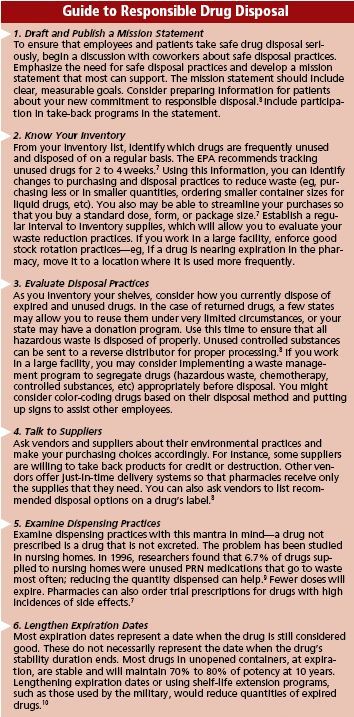Publication
Article
Pharmacy Times
Responsible Drug Disposal: Creating a Green Practice
Author(s):
When drugs are disposed of improperly, they can end up causing harm to people and the environment or end up in the wrong hands. Here's a guide to keeping your community safe.
When drugs are disposed of improperly, they can end up causing harm to people and the environment or end up in the wrong hands. Here's a guide to keeping your community safe.
It used to be common practice for patients—and health care organizations—to flush unwanted drugs down the toilet. Now, the FDA no longer recommends flushing most drugs because sewage treatment plants lack the capacity to remove pharmaceuticals and personal care product (PPCP) residue. For a small number of medications, the FDA still recommends flushing—if no drug takeback program is in place—because they could be harmful if ingested by someone other than the intended patient.1 Proper drug disposal plagues patients, hospitals, and even nations as they confront excess and expired drug supplies. In 1999, for example, The World Health Organization issued guidelines for drug destruction and disposal after the conclusion of the war in Bosnia left tons of useless donated drugs.
Disposed of improperly, drugs can end up in the wrong hands or cause harm to others or the natural environment. For instance, the fentanyl patch—one of the few drugs recommended for flushing disposal—can cause death in pets, children, and possibly adults.1 The main way pharmaceuticals enter surface waters is from residues that result from incomplete metabolism in the body, but improper disposal is another contributor.

The qualities that make PPCPs ideal for human use—they dissolve easily and don’t evaporate at normal pressure and temperature—mean that they can persist in soil and water resources.2 The US Geological Survey studied 139 streams in 1999 and 2000 and identified pharmaceutical compounds in 80% of the streams they tested.3 Scientists and health officials are concerned about possible cumulative effects of long-term exposure. 1 PPCPs’ long-term effects in humans are unknown because many drugs are approved based on studies lasting only 1 or 2 years and involving small test populations.4
The FDA and the White House Office of National Drug Control Policy wrote broad consumer guidance for proper disposal of prescription drugs in February 2007 and revised them in October 2009.5,6 In August 2010, the Environmental Protection Agency (EPA) issued draft guidance for health care facilities, “Best Management Practices for Unused Pharmaceuticals at Health Care Facilities.”7 The suggested Best Management Practices are designed to help health care facilities reduce the quantity of PPCPs that reach the water supply. Local jurisdictions often issue further guidance or laws. Pharmacists should check with their state and city governments to determine if there are any laws governing drug disposal and pass relevant information on to their patients.
If your pharmacy is committed to disposing of drugs in an environmentally sensitive manner, consider the “How-To” guide in the sidebar.
End Note
The EPA has identified pharmaceuticals in drinking water supplies as a contaminant of emerging concern.5 Pharmaceuticals have now been detected in source waters (lakes, streams, etc), treated drinking water, and treated wastewater.
Although the documented effects of drug residuals on human health is limited, researchers are concerned about the effects 2 drug classes in particular present in the environment—synthetic hormones (which contribute to reproductive irregularities in fish) and antibiotics (which contribute to antibiotic resistance in bacteria). Pharmacists should do their part to ensure that drugs are disposed of properly.
Ms. Wick is a visiting professor at the University of Connecticut School of Pharmacy and a freelance writer from Virginia.
References
- Food and Drug Administration. Disposal of unused medicines: what you should know. http://tinyurl.com/2fq2xor. Accessed June 28, 2012.
- Environmental Protection Agency. Pharmaceutical and personal care products: basic Information. www.epa.gov/ppcp/basic2.html. Accessed June 28, 2012.
- Environmental Protection Agency. EPA inaction in identifying hazardous waste pharmaceuticals may result in unsafe disposal. Report no. 12-P-0508. Published May 21, 2012.
- Daughton CG, Ternes TA. Pharmaceuticals and personal care products in the environment: agents of subtle change? Environ Health Perspect. 1999;107(suppl 6):907-938.
- US Government Accountability Office. Action needed to sustain agencies’ collaboration on pharmacueticals in drinking water (GAO-11-346, August 8, 2011). www.gao.gov/products/GAO-11-346. Accessed June 25, 2012.
- US Food and Drug Administration. How to dispose of unused medicines. www.fda.gov/downloads/Drugs/ResourcesForYou/Consumers/BuyingUsingMedicineSafely/UnderstandingOver-the-CounterMedicines/ucm107163.pdf. Accessed June 25, 2012.
- US Environmental Protection Agency. Guidance document: best management practices for unused pharmaceuticals at health care facilities. water.epa.gov/scitech/wastetech/guide/upload/unuseddraft.pdf. Accessed June 25, 2012.
- Wick JY. Responsible drug disposal. Consult Pharm. 2003;18:788-790.
- Paone RP, Vogenberg FR, Caporello E, et al. Medication destruction and waste measurement and management in long-term care facilities. Consultant Pharm. www.ascp.com/public/pubs/tcp/1996/jan/mdwm.html. Published 1996. Accessed June 25, 2012.
- 10. US Army. Food and Drug Administration (FDA) Shelf-Life Extension Program. www.usamma.army.mil/dod_slep.cfm. Accessed June 28, 2012.
- Wick JY. Limiting pharmacy’s environmental footprint. Consult Pharm. 2003;18:747-759.







